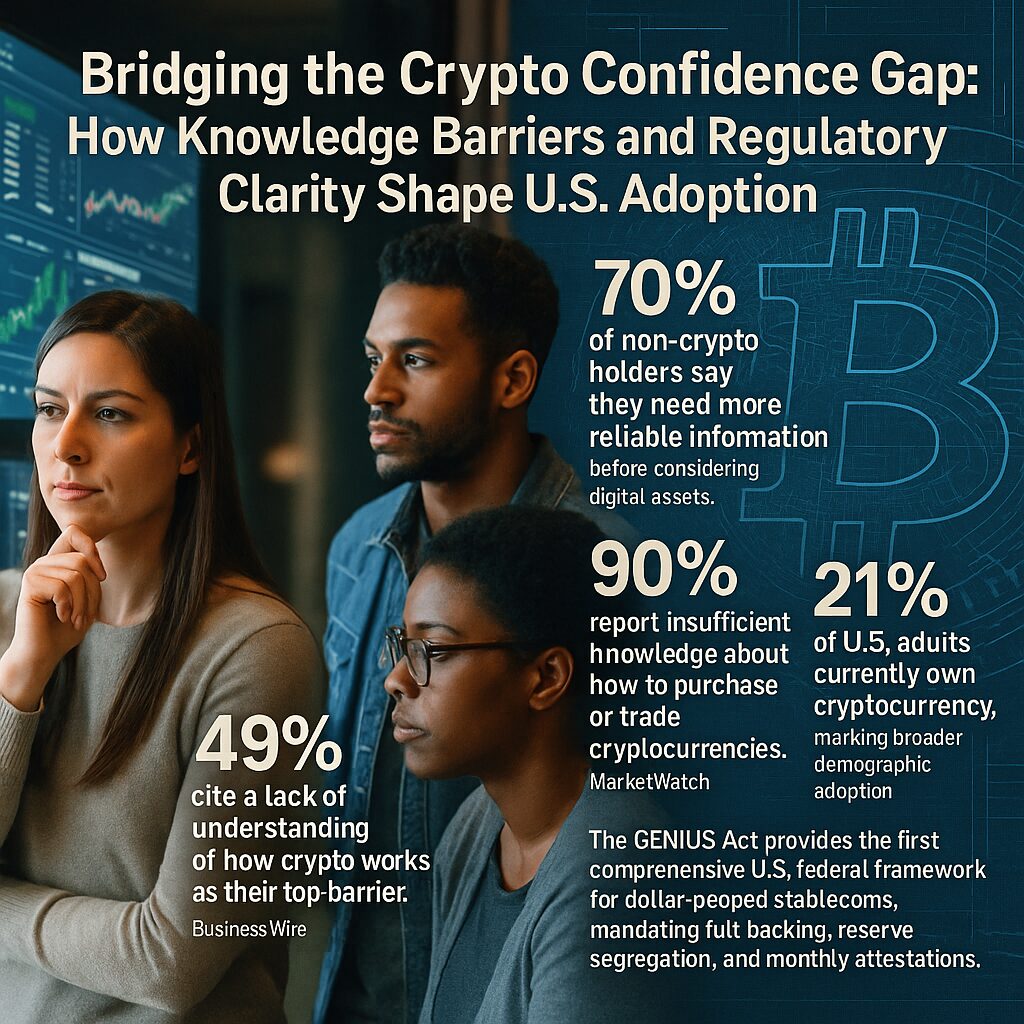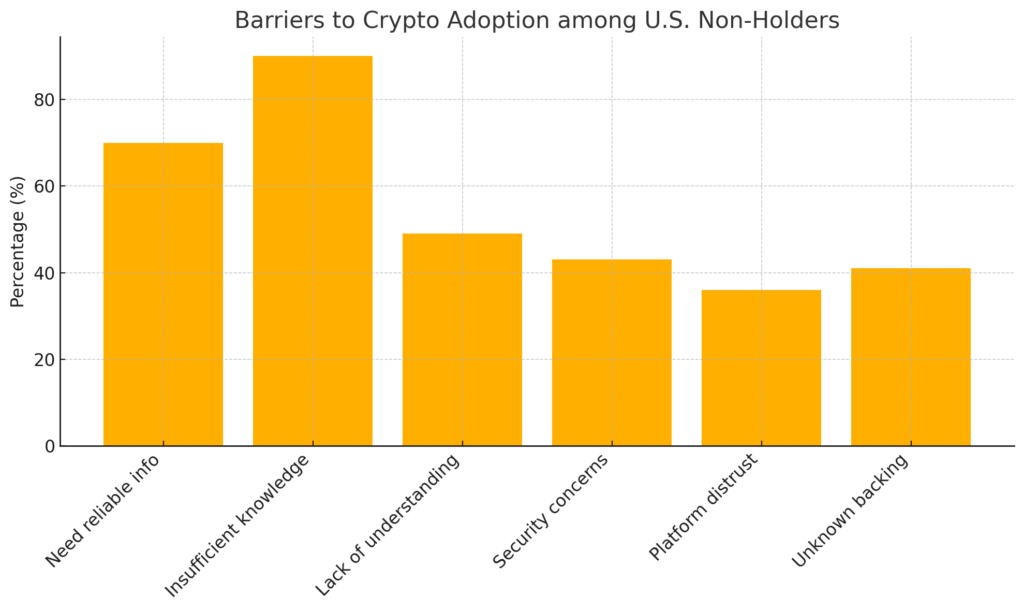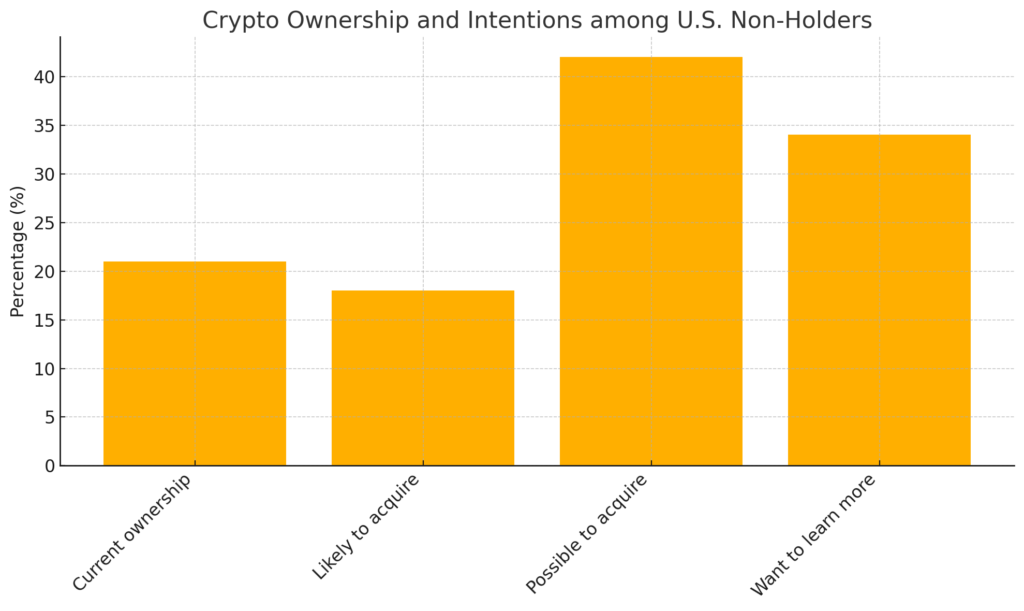
Main Points:
- Widespread Knowledge Deficit: Nearly 90% of non-crypto holders report insufficient knowledge about buying, using, or trading digital assets; 70% need more reliable information before starting.
- Security and Trust Concerns: 43% worry about security and fraud; 36% distrust platforms; 41% don’t understand what backs crypto’s value.
- Curiosity Cohort Emerging: 34% of non-holders want to learn more; among them, 80% view crypto as a legitimate financial asset, and 42% say they might adopt it in 2025.
- Policy Developments Bolster Confidence: The GENIUS Act (signed July 18, 2025) mandates full backing and monthly reserve disclosures for U.S. dollar–pegged stablecoins, enhancing transparency and trust.
- Industry and Educational Initiatives: The NCA has launched video series and outreach programs to demystify crypto and highlight real-world use cases; major firms and banks are exploring stablecoin applications.
Survey Reveals Knowledge Deficit
The National Cryptocurrency Association’s 2025 Crypto Confidence Pulse, based on a Harris Poll of 2,000 U.S. adults who do not hold crypto, underscores that educational gaps remain the most formidable obstacle to mass adoption.
Almost 90% said they lack sufficient knowledge of how to buy, sell, or trade digital assets; about 70% indicated they need more trustworthy information before even considering using crypto.
This deficit is reinforced by the fact that 49% cited a fundamental lack of understanding of how crypto works as their top barrier to entry.
<Figure 1: Barriers to Crypto Adoption among U.S. Non-Holders.>

Security and Trust Concerns
Beyond knowledge, trust issues loom large.
Forty-three percent of respondents expressed concern over security and potential fraud, while 36% reported distrust in crypto platforms and exchanges.
Moreover, 41% said they don’t know what underpins crypto’s value, reflecting confusion around decentralized issuance and reserve mechanisms. As a result, only 18% of non-holders feel likely to acquire crypto in 2025.
The Curiosity Cohort
Despite widespread hesitation, a significant “curiosity cohort” is emerging.
Approximately 34% of non-holders are actively interested in learning more, and of this group, 80% recognize crypto as a valid financial asset.
Furthermore, 42% of the curious cohort indicate they might acquire or use crypto by the end of 2025.
<Figure 2: Crypto Ownership and Intentions among U.S. Non-Holders.>

Policy Developments Bolster Confidence
A landmark policy shift occurred on July 18, 2025, when President Trump signed the GENIUS Act into law, establishing the first comprehensive U.S. stablecoin framework.
The legislation requires dollar–pegged stablecoins to be fully backed by liquid assets and mandates monthly public disclosure of reserve compositions.
Analysts project that with clearer rules, the stablecoin market—currently around $260 billion—could expand to $2 trillion by 2028, as banks and fintechs explore issuing payment-grade stablecoins.
Industry Initiatives and Next Steps
To address the trust and knowledge gaps, the NCA, backed by a $50 million grant from Ripple, has launched an educational video series and consumer outreach programs aimed at debunking myths and demonstrating real-world use cases.
Meanwhile, major enterprises—Walmart, Amazon, Mastercard, and others—are piloting stablecoin-based payment and treasury solutions, signaling that corporate adoption may drive broader consumer awareness and trust.
Financial institutions and regulators alike emphasize that clear, consistent information and practical demonstrations (e.g., in-store crypto payments) are critical to closing the confidence gap.
Conclusion
The 2025 Crypto Confidence Pulse reveals that knowledge deficits and trust concerns are the primary barriers preventing broader U.S. crypto adoption. However, a growing curiosity cohort, combined with landmark policy advances like the GENIUS Act and proactive educational initiatives from organizations like the NCA, point toward gradual but meaningful shifts in perception. As stablecoin frameworks stabilize and industry players showcase real-world utility, the path to mainstream crypto use becomes clearer, setting the stage for the next phase of digital asset growth.

